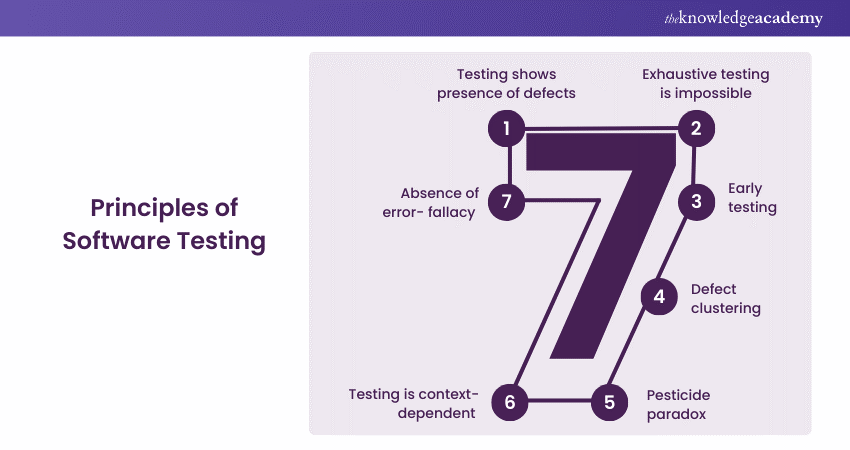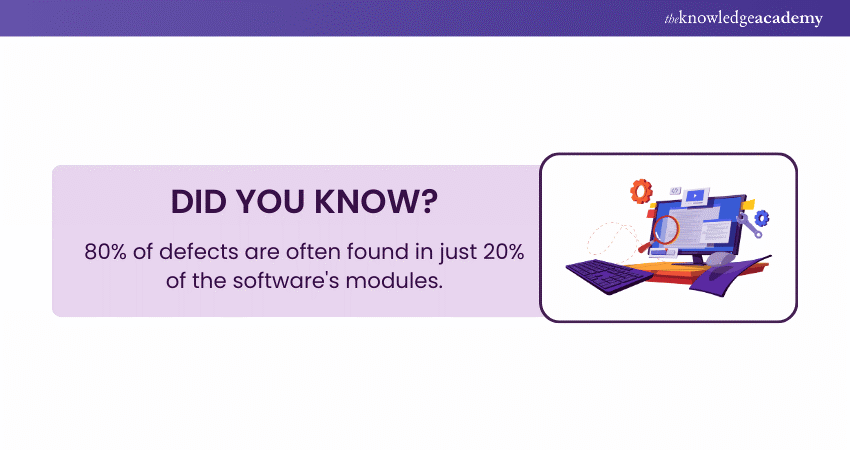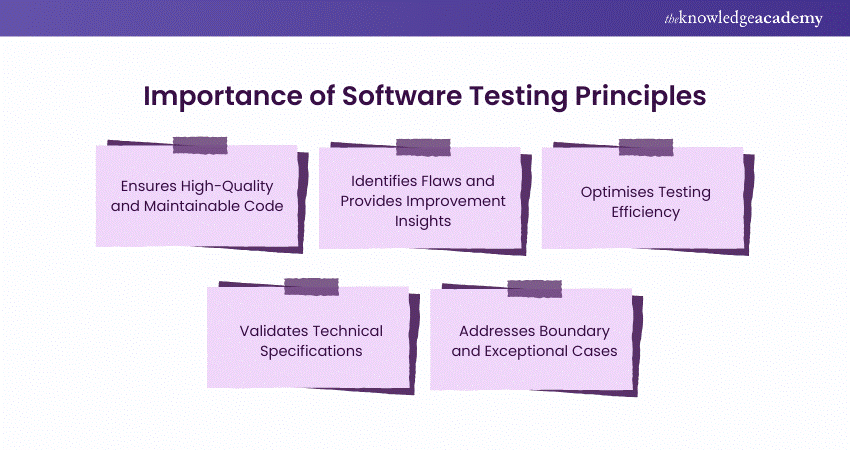We may not have the course you’re looking for. If you enquire or give us a call on +800 312616 and speak to our training experts, we may still be able to help with your training requirements.
We ensure quality, budget-alignment, and timely delivery by our expert instructors.

Software Testing Software Testing is an intrinsic process in the Software Development Life Cycle (SDLC) that reveals the gaps, errors, and defects in the product, as outlined in various Software Testing Books that discuss the importance of effective testing in development. Most bugs and errors must be removed during testing to make a software or application perform. The process is based on basic software testing principles, allowing individuals and businesses to evaluate the software based on the requirements gathered via system specifications and users.
Based on a report, Software testing is expected to grow at a compound annual growth rate (CAGR) of 7% from 2024 to 2032. While automation and AI have simplified the testing process greatly, there are certain use cases where manual testing is essential. Software Testers with knowledge of these basic principles of Software Testing are in high demand in the Information Technology (IT) domain. Read this complete blog to learn and understand what Software Testing Principles are and why they are crucial in software development.
Table of Contents
1) Seven Principles of Software Testing
a) Testing Shows the Presence of Defects
b) Exhaustive Testing is Impossible
c) Early Testing
d) Defect Clustering
e) Pesticide Paradox
f) Testing is Context-dependent
g) Absence of Error- fallacy
2) Importance of Software Testing Principles
3) Conclusion
Seven Principles of Software Testing
Software Testing over the years has become an immensely imaginative and intellectual activity for Testers. Therefore, every Software Tester should have at least a rudimentary understanding of these principles. The following seven principles of Software Testing have been defined by ISTQB and are an essential component of their certification. Understanding these principles will ensure high-quality standards and satisfy the clients' needs regarding the product’s market readiness.

1) Testing Shows the Presence of Defects
Bugs in Software Testing highlight defects in the code rather than proving their absence. This process does not guarantee that the software is entirely bug-free or without issues. Instead, it focuses on identifying Bugs in Software Testing by intentionally finding ways to make the software fail during testing, allowing errors in the code to be detected and fixed.
Testing reduces the number of undiscovered defects in software. However, finding and resolving these issues does not make the software or system 100% error-free. The objectives of Software Testing should always be acknowledged by the quality assurance and testing teams, who must manage client expectations accordingly. Clients can be reassured about the testing process with a comprehensive test strategy that includes extensive test plans, software testing documentation, and testing release plans. Once a system goes into production, constant vigilance and monitoring are required. Anticipating potential issues that might arise with the software also mitigates future problems. One example of this might be extensive load testing of a revamped or newly launched website to ensure that larger-than-expected traffic on the site does not break it.
2) Exhaustive Testing is Impossible
Exhaustive testing is the process of testing a software’s functionality with all possible valid and invalid inputs and pre-conditions. No software can ever be tested for every test and use case. Most software is tested with a certain set of test cases, and depending on the results, it is assumed that the software is correct and will produce the correct output in every test case.
Exhaustive testing will require much larger resources both in terms of time and money and is extremely impractical. Most inputs and outputs have an infinite number of combinations; 100 percent testing of software from every possible perspective is not possible.
Even considering a simple example where a screen takes into account the two numbers as input and prints their sum as output, an absurd of time and computational power would be required to test for every combination of numbers to validate those results. If a simple two-line code like this is impossible to test exhaustively, how can entire applications and software that run millions of calculations per second be exhaustively tested?
Exhaustive testing is just a waste of resources without affecting the overall product's quality. Through standard black-box testing and white-box testing strategies, the number of test cases for software can be correctly optimised.
Elevate Test Analysis Skills with ISTQB Advanced Level Test Analyst Course- join now!
3) Early Testing
In the SDLC, testing should ideally start early to detect and rectify any potential mistakes made during the design or requirements phase. Testing should even be done before the coding process begins to discover any errors in the requirements originally set out. This reduces time and money and avoids the hassle of entire code bits being re-written later in the lifecycle. The cost to fix a bug increases severely as the development life cycle progresses.
One of the basic Software Testing Principles is to begin testing early and run it simultaneously with the code-writing process to stop and deal with the problems as early as possible. This is preferable to testing the code once it has been written, as it helps save time and resources. When the testing team encounters issues or breaks in the code, early feedback to the developers and designers is one of the best ways to overcome the hurdles.
4) Defect Clustering
Defect clustering means that some components or modules of software usually contain most of the issues. It is derived from the Pareto principle of 80:20, which means 20 per cent of the code causes 80 per cent of the defects and issues arising in the software. Therefore, segments of the code which are expected to be the most problematic should be tested first, followed by the defects which have been observed.

In large and complex systems, issues are unevenly distributed. The defect density results from several factors like third-party dependencies and integrations, volatile legacy codes, and complicated systems. Components derived from legacy that undergo constant changes are more volatile and, therefore, more susceptible to clustering. However, this comes with its own set of issues, as repetitive testing of the same module with the same test cases will stop yielding results after a certain number of tries.
Lead Testing Projects with our ISTQB Certified Tester Advanced Level Test Management Course - sign up today!
5) Pesticide Paradox
Defect clustering and its eradication leads to the pesticide paradox. It is based on the same theory that when a pesticide or insecticide is used repetitively on land, the insects will start developing immunity against them. Similarly, using repetitive tests on a code to get rid of clustering will mean that it will become difficult to detect new defects.
Reviewing and revising test cases regularly and adding varied test cases will help overcome this issue. Testers must also look for new and emerging techniques to improve their existing processes and make the product bug-free. Using effective code-coverage tools also ensures the given test cases cover all code paths.
Boost your confidence with crucial Software Testing Interview Questions - Study up today!
6) Testing is Context-dependent
Context dependence means different types of applications require different testing techniques. The way you test off-the-shelf antivirus software will be entirely different from the tests used for a full-fledged designing tool. Every software being developed is heterogeneous and has its own identity; therefore, different Software Testing Methodologies, approaches, techniques, and types of testing are required for each of them.
Even multiple software under the same category will require different testing methodologies. An ATM software will have a completely different set of benchmarks and parameters compared to a point-of-sale system at a supermarket.
7) Absence of Error- fallacy
Software becomes useless if it fails to fulfil the users' requirements even if it is 99 percent bug-free. Irrespective of its error-free nature, it is only a failure if it lacks usability and has a bad user interface/experience, or if it does not match the user needs. Even the absence of error fallacy would indicate that finding and fixing the bug would not be helpful for the application if it were impractical and inept at accomplishing the client/user's needs.
Importance of Software Testing Principles
Software Testing Principles play a vital role in ensuring high-quality, reliable, and efficient software delivery. These principles act as guidelines for Software Testing Engineers to detect flaws, improve usability, and meet user requirements effectively. Below are key reasons why adhering to these principles is essential:

1) Ensures High-Quality and Maintainable Code: Software Testing Principles guide engineers in designing bug-free, precise, and maintainable code. By following these principles, testing teams can create robust test cases and strategies that ensure software meets its intended functionality and purpose.
2) Identifies Flaws and Provides Improvement Insights: Testing principles help teams uncover hidden defects in software while offering actionable insights to improve usability, performance, and accuracy.
3) Optimises Testing Efficiency: Adhering to these principles enables testing teams to optimise their time and effort by focusing on high-risk areas and uncovering defects efficiently. This ensures a cost-effective and streamlined testing process.
4) Validates Technical Specifications: These principles emphasise the importance of confirming and validating technical specifications during design and development. This ensures software aligns with user requirements and functions correctly in various scenarios.
5) Addresses Boundary and Exceptional Cases: By focusing on evaluating software functionality and performance, these principles ensure boundary conditions and exceptional cases are thoroughly tested. This reduces the risk of unexpected issues post-deployment and enhances reliability.
Gain robust software performance with our Software Testing Fundamentals - register today!
Conclusion
We hope you understand the seven Software Testing Principles. There is a myth amongst testers that principles are just for reference and they will not use them in practice. This is false, as while these Software Testing Principles can be considered more as guidelines than strict rules, adhering to them makes the life of a Software Tester easier. Experienced Testers have often made these above principles a part of their testing routine and incorporated them into their methodologies to ensure the code is as bug-free as possible. Additionally, preparing for Manual Testing Interview Questions can help solidify your understanding of these principles and improve your interview performance.
Become a Certified Software Testing Pro- sign up for our ISTQB Agile Foundation Extension Course today!
Frequently Asked Questions
What are STLC Principles?

Software Testing Life Cycle (STLC) Principles primarily deal with systematic software testing through various stages, including requirement analysis, test planning, case development, environment setup, execution, and closure. These principles ensure thorough verification and validation, thus improving software quality.
What is RTM in Testing?

In software testing, RTM stands for Requirements Traceability Matrix. It's a document that maps and traces user requirements with test cases to ensure all functionalities are robustly tested, and no requirements are neglected or overlooked.
What are the Other Resources and Offers Provided by The Knowledge Academy?

The Knowledge Academy takes global learning to new heights, offering over 3,000 online courses across 490+ locations in 190+ countries. This expansive reach ensures accessibility and convenience for learners worldwide.
Alongside our diverse Online Course Catalogue, encompassing 19 major categories, we go the extra mile by providing a plethora of free educational Online Resources like News updates, Blogs, videos, webinars, and interview questions. Tailoring learning experiences further, professionals can maximise value with customisable Course Bundles of TKA.
What is The Knowledge Pass, and How Does it Work?

The Knowledge Academy’s Knowledge Pass, a prepaid voucher, adds another layer of flexibility, allowing course bookings over a 12-month period. Join us on a journey where education knows no bounds.
What are the Related Courses and Blogs Provided by The Knowledge Academy?

The Knowledge Academy offers various Software Testing Courses, including the ISTQB Software Testing Foundation Course, ISTQB Advanced Level Test Manager Course and the Certified Software Testing Professional (CSTP) Course. These courses cater to different skill levels, providing comprehensive insights into Software Testing Case Studies.
Our Business Analysis Blogs cover a range of topics related to Software Testing, offering valuable resources, best practices, and industry insights. Whether you are a beginner or looking to advance your Softer Testing skills, The Knowledge Academy's diverse courses and informative blogs have got you covered.
Upcoming Business Analysis Resources Batches & Dates
Date
 Software Testing Automation Course
Software Testing Automation Course
Thu 3rd Apr 2025
Thu 31st Jul 2025
Thu 6th Nov 2025






 Top Rated Course
Top Rated Course



 If you wish to make any changes to your course, please
If you wish to make any changes to your course, please


